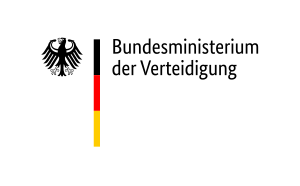Ministry of Defence of Germany facts for kids
| Bundesministerium der Verteidigung | |
 |
|
| Agency overview | |
|---|---|
| Formed | 7 June 1955 |
| Jurisdiction | Government of Germany |
| Headquarters | Bonn, Nordrhein-Westfalen |
| Employees | 3730 |
| Minister responsible |
|
| Website | bmvg.de |
The Federal Ministry of Defence (BMVg) is a very important government office in Germany. It's like the main office for Germany's military, the Bundeswehr. Most of its work happens in Bonn, where about 3,230 people work. There's also a second office in Berlin with about 500 employees.
Contents
What the Defence Ministry Does
The Federal Ministry of Defence is the highest authority for Germany's armed forces. It makes sure the military is well-organized and ready. It has both civilian staff (people who don't wear uniforms) and military staff (soldiers).
The ministry is divided into different groups that handle specific tasks:
- The General Staff helps lead the entire armed forces.
- There are special teams for the Army, Navy, and Air Force.
- One group deals with buying weapons and equipment.
- Another group manages buildings, land, and protecting the environment.
- There's also a team for looking after the people who work there.
- Other groups handle legal matters, money, and making things more modern.
The General Staff is very important for daily operations. It has many smaller teams that work together.
Who Leads the Defence Ministry?
The person in charge of the Federal Ministry of Defence is called the Federal Minister of Defence. This minister is the boss of Germany's armed forces during peacetime. This means they are in charge of all soldiers and military decisions when there is no war.
However, if Germany is attacked or is about to be attacked, the Chancellor takes over command of the armed forces.
A Brief History of the Ministry
The idea for this ministry started in 1950. After World War II, Germany didn't have an army. Chancellor Konrad Adenauer asked Theodor Blank to start planning for a new German army. At first, it was just a small group of 20 people.
By June 7, 1955, this group had grown to 1,300 people. On that day, it officially became the Federal Ministry for Defence. In December 1961, its name changed to the Federal Ministry of Defence.
A big moment in its history was when East and West Germany reunited. The army of East Germany joined the Federal Armed Forces. Later, Germany's army took part in a mission in Kosovo. This was the first time German soldiers fought outside Germany since World War II.
Past Federal Ministers of Defence
Many different people have served as the Federal Minister of Defence since 1955. Here is a list of who held this important job:
| German Ministers of Defence | |||||
|---|---|---|---|---|---|
| No | Name | Life data | Term start | Term end | Party |
| 1 | Theodor Blank | 1905-1972 | 7 June 1955 | 16 October 1956 | CDU |
| 2 | Franz-Josef Strauß | 1915-1988 | 16 October 1956 | 11 December 1962 | CSU |
| 3 | Kai-Uwe von Hassel | 1913-1997 | 11 December 1962 | 1 December 1966 | CDU |
| 4 | Gerhard Schröder | 1910-1989 | 1 December 1966 | 21 October 1969 | CDU |
| 5 | Helmut Schmidt | 1918-2015 | 21 October 1969 | 10 July 1972 | SPD |
| 6 | Georg Leber | 1920-2012 | 10 July 1972 | 1 February 1978 | SPD |
| 7 | Hans Apel | 1932-2011 | 17 February 1978 | 1 October 1982 | SPD |
| 8 | Manfred Wörner | 1934-1994 | 4 October 1982 | 18 May 1988 | CDU |
| 9 | Rupert Scholz | 1937- | 18 May 1988 | 21 April 1989 | CDU |
| 10 | Gerhard Stoltenberg | 1928-2001 | 21 April 1989 | 31 March 1992 | CDU |
| 11 | Volker Rühe | 1942- | 1 April 1992 | 26 October 1998 | CDU |
| 12 | Rudolf Scharping | 1947- | 28 October 1998 | 19 July 2002 | SPD |
| 13 | Peter Struck | 1943-2012 | 19 July 2002 | 22 November 2005 | SPD |
| 14 | Franz Josef Jung | 1949- | 22 November 2005 | 27 October 2009 | CDU |
| 15 | Karl-Theodor zu Guttenberg | 1971- | 28 October 2009 | 3 March 2011 | CSU |
| 16 | Thomas de Maizière | 1954- | 3 March 2011 | 17 December 2013 | CDU |
| 17 | Ursula von der Leyen | 1958- | 17 December 2013 | 17 July 2019 | CDU |
| 18 | Annegret Kramp-Karrenbauer | 1962- | 17 July 2019 | Present | CDU |

